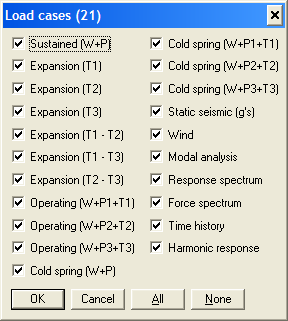Our Services
- Design and Engineering
- INFOplant™ System
- Engineering Management
- List of Projects
- Project Gallery
- Videos
Software Solutions
- CAEPIPE
- checkSTRESS
- dataTRANSLATORS
- HOTclash
- Pricing Request
- Download Free Evaluation
- Customer Support
Learn More
Company Information
CAEPIPE Analysis
CAEPIPE performs linear and non-linear static and dynamic analyses of 3D piping systems using optimized, tested and verified solution algorithms using some of the most advanced programming methods available. Below, you will find a sampling of the types of analyses you can do with CAEPIPE.
See Video of Analysis Speed in action
Types of Loads
- Weight (deadweight and extra unit weight) and multiple pressures
- Multiple temperatures
- Combinations of weight, pressure and temperature
- External forces and moments
- Thermal anchor movements
- Seismic anchor movements
- Static seismic acceleration (g-load)
- Non-repeated anchor movement
- Seismic response spectra
- Force spectra
- Harmonic loads
- Time history loads

Load cases you can select for analysis
Automatic Spring Hanger design from a library of 30+ hanger catalogs
Modal Analysis – Fast Eigenvalue solver
Seismic Response Spectrum Analysis
-
Support for Multiple Spectra Types
- Frequency (or period) versus Displacement
- Frequency (or period) versus Velocity
- Frequency (or period) versus Acceleration
Linear or logarithmic interpolation
Multiple units supported
Spectra can be entered interactively or through a text file
Closely Spaced Modes (using NRC Reg. Guide 1.92)
Time History Analysis
- Time functions can be input inside CAEPIPE or imported from a text file
Harmonic Analysis
Buried Piping Analysis
Force Spectrum Analysis
- Force spectra functions can be input inside CAEPIPE or imported from a text file or can convert existing time functions into force functions.
FRP Piping Analysis

